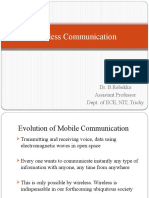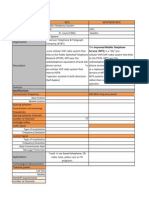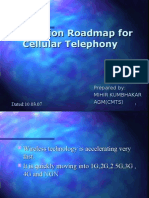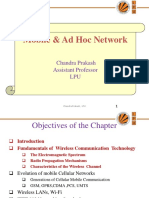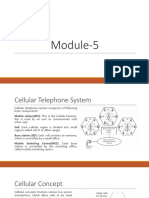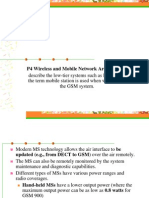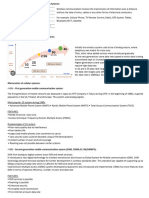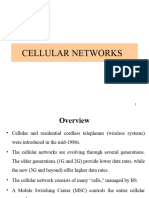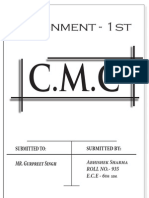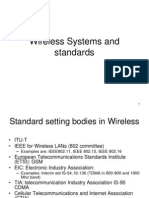0 ratings 0% found this document useful (0 votes) 8 views 23 pages MWC Chapter 1
The document provides an overview of the evolution of mobile communication systems from first-generation analog systems to third-generation digital networks. It discusses the transition from analog to digital technologies, highlighting key standards like GSM and CDMA, and their impact on mobile communication capabilities. Additionally, it covers various technologies and features that have emerged over the years, including power control, modulation techniques, and the role of mobile stations and switching centers.
AI-enhanced title and description
Copyright
© © All Rights Reserved
We take content rights seriously. If you suspect this is your content,
claim it here .
Available Formats
Download as PDF or read online on Scribd
Go to previous items Go to next items
Save MWC chapter 1 For Later pee o.15bpsiz
islency Max.rate 64kbps
TDMA & CDMA
FOMA
26
Digital modulation
Canveiution coding
Power control
ppc
osm
HsesD
GPRS
1s-54/18-136
Untreduction te Wireless Communication Sytem
a.30bpsiHz
Max. rate 2Mbps
TOMA, CDMA and WCDMA
28686
Hierarchal cell structure
‘Turto-coding
EDGE
cdmazo00
WCDMA/UNTS
3G 1X EV-DO
3G 1X EV.DV
1S-95/18-95A/IS-958
PHS
PHS: Personal handy phone system (Japan)
MINO: Multnout and mult-output
OFDM: Orthogonal Frequency Division Multipla Access
igure: Wireless Network fromsG to.4¢
LL1 The First Generation System (Analog)
3. 4bpsiHz (targeted)
Max. rate ~ 200 Mbps
WeDMA
4g
‘Smart antennas?
MNO?
Adaptive system
OFDM modulation
@ In 1980 the mobile cellular era had started, and since then mobile
communications have undergone significant changes and experienced
enormous growth. Fig. above shows the evolution of the mobile networks.
First-generation mobile systems used analog transmission for speech services.
In 1979, the first cellular system in the world became operational by Nippon
Telephone and Telegraph (NTT) in Tokyo, Japan.
© ‘wo years later, the cellular epoch reached Europe. The two most popular
analog systems were Nordic Mobile Telephones (NMT) and Total Access
Communication Systems (TACS). Other than NMT and TAGS, some other
analog systems were also introduced in 1980s across the Europe. In the United
States, the Advanced Mobile Phone System (AMPS) was launched in 1982.
All of these systems offered handover and roaming capabilities but the cellular networks were
unable to interoperate between countries. This was one of the inevitable disadvantages of
first-generation mobile networks�Untreduction te Wireless Communication Sytem
112. The Second-generation & Phase 2+ Systems(z.5G) (Digital)
Second-generation (2G) mobile systems were introduced in the end of 1980s. Low bit
rate data services were supported as well as the traditional speech service. Compared
to first-generation systems, second-generation (2G) systems use digital multiple
access technology, such as TDMA (time division multiple access) and CDMA (code
division multiple access). Consequently, compared with first-generation systems,
higher spectrum efficiency, better data services, and more advanced roaming were
offered by 2G systems.
In Europe, the Global System for Mobile Communications (GSM) was deployed to
provide a single unified standard. This enabled seamless services throughout Europe
by means of international roaming. Global System for Mobile Communications, or
GSM, uses TDMA technology to support multiple users During development over more
than 20 years, GSM technology has been continuously improved to offer better services
in the market. New technologies have been developed based on the original GSM
system, leading to some more advanced systems known as 2.5 Generation (2.5G)
systems.
some of the 2.5G systems are:
General Packet Radio Service(GPRS): added packet-switching protocols, shorter setup
time for ISP connections, and the possibility to charge by the amount of data sent,
rather than connection time.
EDGE (Enhanced Data rates in GSM Environment): With both voice and data traffic
moving on the system, the need was felt to increase the data rate. This was done by
using more sophisticated coding methods over the internet and thus increasing the
data rate up to 384 kbps.
11.3 The Third-generation
It was decided to have a network which provides services independent of the
technology platform and whose network design standards are same globally. Thus, 3G
was born, The International Telecommunication Union (ITU) defined the demands for
3G mobile networks with the IMT-2000 standard. An organization called 3rd
Generation Partnership Project (sGPP) has continued that work by defining a mobile
system that fulfills the IMT-2000 standard. In Europe it was called UMTS (Universal
Terrestrial Mobile System).�Untreduction te Wireless Communication Sytem
Table: Comparison of 1G,2G &3G.
Nouns Comasucanes stone An Stans
Propesty ie 26 256 36
Stati Tan | oes 1992, 1998 >on
saalogue signa! Digital sisal intel die Intllzct signal
cee moves processing
SMCS /EAGRINNOY —_KEMOTOMA GPRS. Fos, M2000 «UMTS.
ICS /TAGRENMOE RMN scsi, EDGE WCDMA, CDMA2000)
Redo Preqnaney (HA AU0Nt-S0001 S00.9004, 1800-19008 6
Bait (bps) 24K 0K, uk IRIE 2M
Mult ads
Tesluigne
Cellar Coverage Lange aea ‘edie area Sul ase
FDMA TDMA, CDMA epysa
Teleco elon,
Sone IF eters
Voice, Ss Voice Dats
Monc-nein Dt sevice Some Mine
sre person Peron te-machine
Core Nerwouks| Telecom netwooks
a fixed station in a mobile radio system used for radio communication with
mobile stations. Base stations are located at the center or on the edge of a coverage
region and consist of radio channels and transmitter and receiver antennas mounted
ona tower.
Mobile Station:
A station in the cellular radio system intended to use while in motion at unspecified
locations is called a mobile station. Mobile stations may be hand-held personal units
(portables) or installed in vehicles (mobiles)
Mobile Switching Center (MSC)
An MSC also called a Mobile Telephone Switching Office (MTSO) is a switching center
which coordinates the routing of calls in a large service area. Ina cellular radio system,
the MSG connects the cellular base stations and the mobiles to the PSTN (Public
Switched Telephone Network, PSTN, is a global telecommunications network which
connects conventional landline telephone switching centers, called central offices,
with MSCs throughout the world).�Untreduction te Wireless Communication Sytem
Control Channel:
Ivis a radio channel used for transmission of call setup, call request, call initiation and
other beacon or control purposes.
Forward Channel
It is a radio channel used for transmission of information from the basestation tothe
mobile.
Reverse Channel:
Itis aradio channel used for transmission of information from the mobile to the base
station.
The process of transferring a mobile station from one channel or base station to
another is called handoff.
Roamer
Amobile station which operates in a service area (market) other than that from which
service has been subscribed is called a roamer.
Page:
Abrief message which is broadcast over the entire service area, usually in a simulcast
fashion by many base stations at the same time is called a page.
‘Transceiver:
A device capable of simultaneously transmitting & receiving radio signals.
1.3 Mobile radio system around the world:
1.3.1 Advanced Mobile Phone System (AMPS):
© Advanced Mobile Phone System (AMPS) is an analog mobile cell phone system
standard developed by Bell Labs, and officially introduced in the America’s in
1978, Israel in 1986, & Australia in 1987. Itwas the primary analog mobile phone
system in North America through the 1980s & into the 2000s.
© AMPS is the first generation cellular technology thatuses separate frequencies,
or “channels’,for each conversation, It therefore required considerable
bandwidth for large number of users. In general terms, AMPS was very similar
4.�Untreduction te Wireless Communication Sytem
to the older “oG" Improved Mobile Telephone Service, but used considerably
more computing powerin order to select frequencies, hand off conversations to
Public Switch Telephone Network (PSTN) lines, and handle billing & call setup.
@ What really separates AMPS from older systems is the “backend” call setup
functionality. In AMPS , the cell centers could flexibly assign channels to
handsets based on signal strength, allowing the same frequency to be re-used in
various locations without interference. This allowed a larger numberof phones
to be supported over a geographical area. AMPS pioneers coined the term
“cellular” because of its use of small hexagonal “cells” within a system.
@ AMPS suffered from many weakness when compared to todays digital
technologies. As an analog standard, it was very susceptible to static & noise,
and had no protection from eavesdropping using a scanner.
@ AMPS cellular service operated in the 850MHz cellular band. For each market
area, the United States Federal Communications Commission (ECC) allowed
two licenses (networks) known as “A” & “B” carriers. Each carrier within a
market used a specified “block” of frequencies consisting of 21controlchannels
& 395 voice channels. originally, the B (wireline) sidelicense was usually owned
by local phone company, & the A (non-wireline) license was given to wireless
telephone providers.
1.3.2, Narrowband Advanced Mobile Phone System (N-AMPS):
@ To increase capacity in large AMPS markets, Motorola developed an AMPS like
system called N-AMPS.
@ N-AMPS provides three users in 30 kHz AMPS channels by using FDMA & 10
kHz channels, & provides three times the capacity of AMPS.
@ By replacing AMPS channels with 3 N-AMPS channels at one time, service
providers are able to provide more trunked radio channels at base stations in
heavily populated areas. N-AMPS uses SAT (Supervisory Audio Tone) signaling
and blank & burst functions in exactly the same manner as AMPS, except the
signaling is done by using sub audible data streams.
@ Since 10 kHz channels are used, the FM deviation is decreased. This in turn
reduces the S/N which degrades the quality with respect to AMPS. To
counteract this, N-AMPS uses voice companding to provide a “synthetic” voice
channel quieting.
© The voice channel signaling is done with 1oobps Manchester encoded FSK data
& is sent in place of DSAT when traffic must be passed onthe voice channel. As.
with AMPS wideband signaling,there are many messages that may be passed
5�Untreduction te Wireless Communication Sytem
between the base station & subscriber unit, and these are transmitted in
N-AMPS using the same Bose-Chaudhuri (BCH) code in AMPS with a
predefined format of 49 bit blocks on the FVC & 48 bit blocks on the RVG.
(Blank & Burst functions: Itis the technique where by the voice signal is blanked for
aboutso ms & data burst ofio kb/s isinsertedinthe voice channel. This signalisused
{for feature as alerting the mobile about channel transfer for handoff)
12.3 Global System for Mobile communication (GSM):
© Gm is a standard set developed by the European Telecommunication Standard
Institute (ETSI) to describe protocols for second generation digital cellular
network used by mobile phones. It became the global standard for mobile
communications with over 80% market share.
@ The GSM standard was developed as a replacement for first generation (1G)
analog cellular networks, and originally described a digital, circuit switched
network optimized for full duplex voice telephony. This was expanded overtime
to include data communications,first by circuit switched transport, then packet
data transport via GPRS (General Packet Radio Services) and EDGE (Enhanced
Data rates for GSM Evolution or EGPRS).
@ In order to gain access to GSM services, a user needs three things:
a. Abilling relationship with a mobile phone operator. This is usually either
where services are paid for in advance of them being consumed (prepaid),
or where bills are issued and settled after the service has been consumed
(postpaid).
b. A mobile phone that is GSM compliant & operates at the same frequency
as that of the operator.
c. A subscriber Identity Module (SIM) card, which is activated by the
operator once the billing relationship is established. After activation, the
card is then programmed with the subscriber's Mobile Subscriber
Integrated Services Digital Network Number (MSISDN) (che telephone
number). Personal information such as contact numbers of friends and
family can also be stored on the SIM by the subscriber.
©@ Afier subscriber sign up, information about their identity (telephone number)
and what services they are allowed to access are stored in a“$IMrecord” in the
Home Location Register (HLR).
© Once the SIM card is located into the phone and the phone is powered on, itwill
search for the nearest mobile controlling station (also called as Base Transceiver
Station/ BTS) with strongest mobile phone signal in the operator's frequency
a�Untreduction te Wireless Communication Sytem
band. If'a BTS successfully connected, then there is said to be coverage in area.
The phone then identifies itself to the network through the control channel.
Once successfully completed, the phone is said to be attached to the network.
© The key feature of a mobile phone is the ability to receive & make calls in any
area where coverage is available. This is generally called roaming from a
customer perspective but also called visiting when describing the underlying
technical process.
@ Each geographic area has a database called the Visitor Location Register (VLR),
which contains details of all the mobiles currently in that area. Whenever a
phone attaches, or visits, a new area,the Visitor Location Register must contact
the Home Location Register (HLR) to obtain the details for that phone. The
current cellular location of the phone is entered intothe VLR record and will be
used during a processed called paging when the GSM network wishes to locate
the mobile phone.
@ Every SIM card can contains a secret key, called the “Ki’, which is used to
provide authentication and encryption services. This is useful to prevent theft,
and also prevent “over the ait” snooping of a user's activity. the network does
this by utilizing the authentication center & accomplished without
transmitting the key directly.
@ Every GSM phone contains a unique identifier called the International Mobile
Equipment Identity (IMEI). A phone contacts network, its IMEI may be
checked against the Equipment Identity Register (EIR) to locate stolen phone &
facilitate monitoring.
13.4 IS- 95 (IS-95 CDMA System):
@ Qualcomm proposed the CDMA radio system for digital cellular phone
applications. It was optimized under existing U.S. mobile cellular system
constraints of the advanced mobile phone system (AMPS). The CDMA system
uses the same frequency inall cells and all sectors.
@ The system design has been standardized by the TIA as IS-95 and many
equipment vendors sell CDMA equipment that meet the standard. The 18-95
CDMA system operates in the same frequency band as the AMPS using
frequency division duplex (FDD) with 25 MHz in each direction.
© The uplink (mobile to base station) and downlink (base station to mobile) bands
use frequencies from 869 to 894 MHz and from 824 to 849 MHz, respectively.
@ The CDMA channels are defined in terms of an RE frequency and a code
sequence. Sixty-four Walsh codes are used to identify the forward channels,
Je�Untreduction te Wireless Communication Sytem
whereas unique long PN code offsets are used for the identification of the
reverse channels.
@ The modulation and coding features of the IS-95 CDMA system are listed in
Table given below:
Table: Features of IS-95 CDMA.
Modulation Quadrature phase shift keying (QPSK)
Chip rate 1.2288 Mcps
Nominal data rate | 9600 bps
Filtered bandwidth 1.25 MHz
Coding Convolution with Viterbi decoding
Interleaving With 20-msee span
© Modulation and coding details for the forwardand reverse channels differ. Pilot
signals are transmitted by each cell to assist the mobile radio to acquire and
track the cell site downlink signals. The strong coding helps these radios to
operate effectively at an Eb /No ratio ofa 5 to 7dB range.
@ The CDMA system (15-95) uses power control and voice activation to minimize
mutual interference. Voice activation is provided by using a variable rate
vocoder. A bit-interleaver with 20 msec span is used with error-control coding
to overcome multipath fading and shadowing.
@ The time span used is the same as the time frame of voice compression
algorithm. A Rake receiver used in the CDMA radio takes advantage of a
multipath delay greater than 1s, which is common in cellular/personal
communication service networks in urban and suburban environments.�Untreduction te Wireless Communication Sytem
14 Applications of wireless communication systems
14.1 Paging System:
@ Paging system are communication systems that sends brief (short) message to
subscriber. Depending on the type of service, the message may be either a
numeric message, an alphanumeric message or a voice message.
@ Paging systems are typically used to notify a subscriber of the need to call a
particular telephone number or travel to know location to receive farther
instructions.
ws oss
—\ 4 rsa
Suite ink
Figure: Paging System
© In modern paging system news headlines,stock quotation & faxes maybe sent.
A message is sent to a paging subscriber via the “Paging System Access
Number” with a telephone keypad or modem.
@ The issued (transmitted) message is called PAGE. The paging system then
transmits the page throughout the service area using base station which
broadcast the page on a radio carrier.
@ Paging systems are vary widely in their complexity & coverage area. while
simple paging systems may cover a limited range of2km to skm, or may even be
confined within individual buildings, wide area paging systems can provide
worldwide coverage.
© Though paging receivers are simple & inexpensive, the transmission system
required is quite sophisticated. Wide area paging systems consists ofa network
of telephone lines, many base station transmitter, and large radio tower that
simultaneously broadcast a page from each base station [ THIS IS CALLED
SIMULCAST].�Intreduction te Wireless Communication System
© Simulcast transmitter may be located within the same service area or in
different cities or countries. Paging systems are designed to provide reliable
communication to subscriber wherever they are.
@ This necessitates large transmitter power & low data rates for maximum
coverage from each base station.
1.4.2 Cordless Telephone Systems:
© Cordless telephone systems are full duplex communication systems that use
radio to connect a portable handset to a dedicated base station.
@ Which is then connected to a dedicated telephone line witha specific telephone
number on the PSTN. In first generation cordless telephone system, the
portable unit communicates only to the dedicated base unit & only over
distance of few meters.
Public
Switched Fixed Port
Telephone Base Station
Networle ~ Wireless Link
(PSTN) a
Cordless Handset
Figure: Cordless System
@ Second generation cordless telephones have been introduced which allows
subscriber to use their handset at many outdoor locations.
© Cordless telephones provide the user with limited range and mobility, as it is
usually not possible to maintain a call if the user is travelling outside the range
of base station. Typically second generation base station provides coverage
ranges up to few 100's of meters.
~10-

